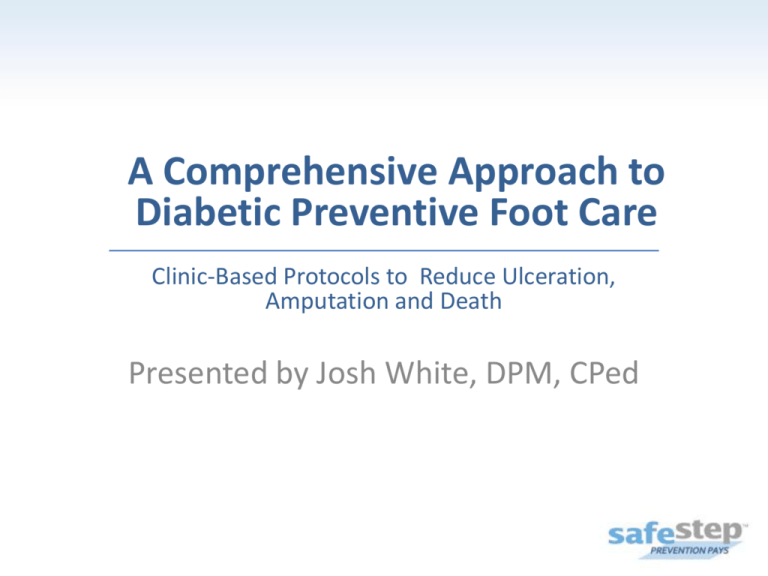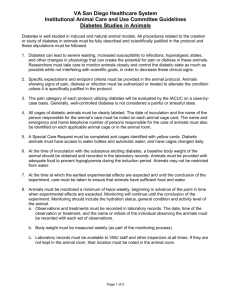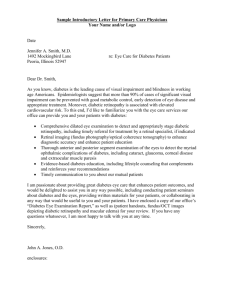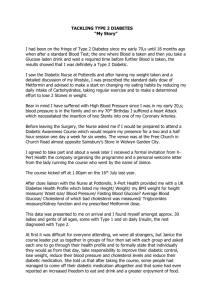Fall Risk Management & The Moore Balance Brace
advertisement

A Comprehensive Approach to Diabetic Preventive Foot Care Clinic-Based Protocols to Reduce Ulceration, Amputation and Death Presented by Josh White, DPM, CPed Podiatry & Diabetic Ulceration • Risk problems are not being identified or adequately addressed prior to ulceration. • Ulcerations can be prevented! • Podiatrists can... o o o …decrease the likelihood of ulceration. …decrease the likelihood of amputation. …decrease the likelihood of death. • It’s estimated that as many as 60% of amputations resulting from diabetes‐related complications can be prevented. Ortegon MM, Redekop WK, Niessen LW. “Cost Effectiveness of Prevention and Treatment of the Diabetic Foot.” Diabetes Care April 1, 2004;27(4):901-7. Topics 1. The scope and economic realities associated with diabetic ulceration. 2. Taking a preventative care approach. 3. Benefits for patients and practice revenue projections. Scope of the Problem in the U.S. • 29.1 million people – or 9.3% of the population – have diabetes. o 1 of 4 do not know they have diabetes. • For those aged 65 and over, 25.9 % have diabetes. • 86 million people – 1 in 3 of us – have prediabetes. o 9 of 10 do not know that they have prediabetes. • Diabetes is the leading cause of limb loss in the US accounting for more than 75,000 annual amputations. National Health and Nutrition Examination Survey estimates applied to 2012 U.S. Census data. Palumbo PJ, Melton LJ. Peripheral vascular disease and diabetes. In: Harris MI, Hamman RF, editors. Diabetes in America. Washington: US Government Printing Office; 1985. pp. 16–21. NIH Pub. No. 85-1468. Pendsey S. Diabetic Foot: A Clinical Atlas. Jaypee Brothers Medical Publishers. 2003. Brownrigg, et al, Diabetologia, 2012 Bongaerts, et al, Diabetes Care, 2013 Scope of the Problem in the U.S. • More than 90% of people with diabetic peripheral neuropathy are unaware they have it. • 15 – 20% of patients with diabetic foot ulcers go on to an amputation. • Diabetic foot ulcers double mortality and heart attack risk while increasing risk for stroke by 40%. National Health and Nutrition Examination Survey estimates applied to 2012 U.S. Census data. Palumbo PJ, Melton LJ. Peripheral vascular disease and diabetes. In: Harris MI, Hamman RF, editors. Diabetes in America. Washington: US Government Printing Office; 1985. pp. 16–21. NIH Pub. No. 85-1468. Pendsey S. Diabetic Foot: A Clinical Atlas. Jaypee Brothers Medical Publishers. 2003. Brownrigg, et al, Diabetologia, 2012 Bongaerts, et al, Diabetes Care, 2013 Economic Realities in the U.S. • Average healthcare cost of a single wound has been estimated as high as $28k/year1 • Lifetime healthcare costs for a person with diabetes is typically double non-diabetes – in excess of $500,0002 • The total estimated cost of diagnosed diabetes in 2012… o $245 billion3 ($176 billion in direct medical costs, $69 billion in reduced productivity. ) • Nearly 6% of total healthcare cost. 1. Harrington C, Zagari MJ, Corea J, Klitenic J. " A Cost Analysis of Diabetic Lower- Extremity Ulcers.“ 2. Blough DK, Hubbard S, McFarland LV, Reiber GE, Smith DG, Gambel JM. " Prosthetic Cost Projections for Service members with Major Limb Loss From Vietnam and OIF/OEF." Journal of Rehabilitation Research and Development 2010; 47(4):387-402. Alemayehu B, Warner KE. "The Lifetime Distribution of Health Care Costs." Health Services Research 2004; 39(3):627-42. 3. American Diabetes Association Risk Factors for Diabetic Foot Ulcers • • • • • Deformity Peripheral Artery Disease Peripheral Neuropathy Previous Foot Wound Prior Amputation Additional Risk Factors • • • • • • • Smoking Malnutrition Immobility Older Age Deficits in Cognitive Function Visual Impairment Dialysis The Preventive Care Approach • Identify every patient in your practice with diabetes. • Perform a Comprehensive Diabetic Foot Exam (CDFE). • CDFE should be performed at least annually according to the American Diabetes Association, Standards of Care. • The increased number of shoes dispensed through this program will have significant positive impact on patient health and meaningfully decrease the cost to the healthcare system. CDFE Close Up The Numbers • Do not be distracted by whether or not you’ll be reimbursed for performing a CDFE. • Profitability from performing a CDFE doesn’t result from testing but from diagnosis. The Numbers • Perform a CDFE on all Medicare patients with diabetes. • Not all will have a qualifying risk factor but … • …75% or more will qualify, resulting in both reimbursement for the exam + for shoes. • Patients win & you win! The Numbers • Most practices have 250 Medicare patients with diabetes. o (Many have up to 1000 – even more.) • 75% will qualify for reimbursement + for shoes = 185 patients. • $60 exam + $225 shoes = $285 o • • • • ($225 shoes are average of 50% custom inserts, 50% prefab inserts.) $285 X 185 patients = $52,725/year net revenue increase. Avg. podiatrist median net income appx. $150k/year. CDFE = appx. 33% increase in annual net revenue. 1000 Medicare patients = $210,900 additional net revenue. The Numbers - Review • All patients receive the care required to reduce likelihood of ulceration and amputation. • Cost to Medicare is reduced by magnitudes. • Podiatric practice revenue increases substantially. • Win – Win - Win Why Do Most DPMs Forego the Benefits of Comprehensive Diabetic Prevention? FEAR! • Fear of Medicare audits • Fear of time constraints / too busy • Fear of looking like a shoe salesman Fear of Audits • Know the rules. • Educate your support staff. • Consider SafeStep’s ‘WorryFree DME’ program. Medicare Compliance Got You Down? Register today for SafeStep’s WorryFree DME program and enjoy all the benefits of increased practice growth without all the tedious paperwork. You enter the patient data and we’ll do the rest! • We contact the medical doctor • We gather the signed forms • We check to make sure the info is right • We create every other Medicare required form • We even guarantee Medicare compliance* WorryFree DME For more information about WorryFree DME call 866.712.STEP (7837) *Ask about our $10,000 Guarantee Fear of Looking Like a Shoe Salesman • Get over it. • You are providing necessary, potentially lifesaving care. • You are enhancing your bottom line. Fear of Time Constraints • Educate your support staff. • Employ a dedicated shoe person for management and implementation of diabetic shoe program. • Medical Assistant national average salary… • $13-$15/hr. • Comprehensive Diabetic Prevention… • +$341/hr. Other Considerations • Peripheral Arterial Disease Testing • PQRS (Measure 127) • Balance & Fall Risk o o o Fall Risk Assessment Moore Balance Brace Appx. $1500 net reimbursement (per pair) • L1940, L2330, L2820 Other Considerations • Affordable Care Act o Driving much of the current healthcare policy debate… • expanding coverage • improving quality • improving outcomes o We believe that implementing clinical models and guidelines that reduce preventable amputations is an integral part of achieving these goals1 1. Limb Loss Task Force/Amputee Coalition, Roadmap for Preventing Limb Loss in America: Recommendations From the 2012 Limb Loss Task Force. Knoxville, Tennessee; 2012. Remainder of the Series… • March 31 – “CDFE & Shoe Fitting” • April 7 – “Ensuring Medicare Compliance with WorryFree DME” • April 14 – “Essentials for Making Your Shoe Program a Winner” Learn more at SafeStep.net Questions?






